Activity is strong at Everest Base Camp, with more still on the trek. The permits increased as expected this past week and will top out fairly soon. They still lag behind last year by over 100 for Everest. The fixed lines are now to Camp 2 in the Western Cwm, ready for more teams to arrive at EBC this week. We saw the first 8000er deaths of the 2022 Spring season this past week.
Big Picture
As of April 15, 2022, the Ministry of Tourism has issued 738 total climbing permits thus far, with 262 for Everest, with 56 female climbers. The United States represents the largest country on Everest this year with 58 climbers, a spot recently ceded to India and China, with only 21 and 9 climbers, respectively. The UK comes in at 33, with Canada at 14 and Australia at ten thus far. Russia has 16 climbers on Everest this season.
Everest Base Camp is rapidly filling up with most teams reviewing basic skills and preparing for their first walk into the Icefall, a big day ahead. See the tracking table for the latest team locations.
Climbers on Dhaulagiri and Annapurna are climbing with summit pushes expected soon. Also, climbing will soon begin on Kachchenunga and Makalu.
Last Week – Deaths
This week brought the usual but always tragic deaths in the mountains. Sadly, two climbers died. First, on Dhaulagiri was highly experienced Greek climber Antonis Sykaris, 59, who died around 7,400m after summiting the 8,167 meters (26,795 ft) peak at 12:40 local time Monday, April 11, 2022. He was climbing with Dawa Sherpa using the logistics of Seven Summits Treks. The other death was Nima Tenji Sherpa, 38, an IMG Sherpa who died while carrying loads along with 11 other Sherpas in the Khumbu Icefall. They were going higher to stock Camp 1. IMG said, “… was found sitting next to the trail still wearing his backpack, lifeless. There was no fall, avalanche, or trauma involved.” My sincere condolences to his family, friends, and teammates of both climbers.
Everest Base Camp
The first days at EBC are always interesting. The primary task is to rest and continue acclimatizing to the altitude, 17,500-feet/5,334-meters. But also it’s a chance to review some basic skills. Most teams set up a course in the ice adjacent to Base Camp with a fixed rope and a ladder. For example, Maddison Mountaineering made this post on their play day:
Today our team of climbers ventured out onto the pinnacles of ice right next to base camp here on the Khumbu Glacier. We practiced the fixed-line technique, traversing on fixed lines, ascending/descending. That’s one of the most fun things we do here in base camp. It’s just like a playground out there on the glacier.
There are reports of WiFi access at EBC being expensive, slow, and unreliable. Not sure how to read this as the definition of “expensive” varies by individual – slow and unreliable is pretty straightforward. Access to WiFi has become standard for all teams on Everest. All are hoping EverestLink will be up on the Nepal side. Last year, I contacted EverestLink about their WiFi prices at EBC and heard back from their General Manager:
| DATA PACKAGE |
RATE (IN NPR) |
RATE (IN USD) |
| 1 GB | 5,000 | $45.04 |
| 2 GB | 7500 | $67.56 |
| 5 GB | 14,500 | $130.62 |
| 10 GB | 20,000 | 180.16 |
So how much is enough? Remember that 1 GB is 1,000 MB. Most people want access to email, text, or WhatsApp, so 1GB would be fine for most people costing around UDS$50. Others might want to FaceTime or Skype, and they will need to bump up to probably 5 GB if they connect every few days. Then for those who want to stream movies or videos from YouTube, break out a couple of hundred bills and buy the 10 GB card.
This list will give you an example of how much each of these scenarios will eat up:
- 1.6 Million Emails 3 KB each (with no attachments)
- 33,000 Web Pages Lookup 150 KB each
- 10,000 Low Res Photos 500 KB each
- 1,600 3 Minute Songs 3 MB each
- 300 3 Minute Youtube Videos 15 MB each
- 29 Hours of Skype Video Calls, 169 MB each
- 14 30 Minute TV Shows 350 MB each
- 3 Movies, 1.5 GB each (fewer if high def)
Next Week – Into the Icefall
This next week the teams already in Everest Base Camp will take their first steps into the Khumbu Icefall, with a few going to Camp 1 and one or two to Camp 2 for their first rotation. The Sherpas will be in full-on work mode ferrying supplies to Camps 1 and 2, so expect to see a steady stream of headlamps in the Icefall starting in the wee hours of each morning.
It will be interesting to see the strategy used for acclimatization. In recent years, it has become more common to have only two rotations tagging 7,000-meters. In addition, some operators have reduced it to one rotation if they start using supplemental oxygen from Camp 2. This program was unheard of even three to five years ago when the standard protocol was at least three rotations, including spending a night at C3 with no O’s. But times are changing, and operators are doing everything to get clients to the summit and back safely, even if it means loading up with the O’s.
8000ers – Carlos on the Move!
Over on Annapurna, Adrian Brownlee posted, “Final prep for summit push – leave 16th for C2, 17th C3, 18th C4, and 19th Summit team all good, conditions at the moment OK – let’s do this! And Allie Pepper gave a similar update.
Hey everyone, hello from Annapurna Base Camp! We now have our summit weather window on the 19th. All forecasts suggest that this day has low winds on the summit. After that 24hr window the wind picks up again and we need to move down the mountain. Dawa and I came back to Base yesterday so we only have had one rest day before we head up again. don’t want to talk too much about the route but it is very difficult between camp 2 and 3 so we need to go in the night. I don’t have much chance to acclimatise up high so just hope for the best! What will be will be and Dawa is carrying emergency oxygen for me just in case.Thank you everyone for your support and I will try to keep you updated through Julie and you can follow my inreach tracker to see how we are going.
And on Dhaulagiri: At C2
Carlos Sori, 83, Sito Carcavilla, and the six Sherpas are at Camp 2 of Dhaulagiri with a solid weather forecast. They acclimatized in the Khumbu, reaching a high of 5,850-meters. Their home team posted on social media:
Carlos Soria and Sito Carcavilla are resting in Dhaulagiri C2, after traveling the path that separated them from Camp I. The weather remains stable and conditions are good. If all goes well tomorrow they could head towards C3
Mimnga G of Imagine Nepal is moving to more 8000ers, with many of the climbers who summited Dhaulagiri last week:
Our team is just back to Kathmandu from successfully climbing Mt Dhaulagiri and the sherpa team are already back on Kanchenjunga and Everest. We have Kanchenjunga, Everest and Lhotse running at the moment and our Makalu will begin in May.
Multiple 8000er Summits – A Trend to Watch
It’s become trendy to attempt multiple 8000-meter summits in the same season. Still, success is rare outside of one pair that is not comparable to the rest. A case in point is the Dhaulagiri climbers now moving to Annapurna. The double became popular in 2011, with Michael Horst linking Everest on May 14 with Lhotse on May 15. Now, 11 years later, that combo has been done 90 times. Looking at Dhaulagiri climbers now moving to Annapurna, only four climbers accomplished that double. Overall, since 2000 there have been 137 doubles achieved by non-Nepalis, and many of these are guides, not “client” climbers.
Using the Himalayan Database, let’s look at some possible combinations between 2000 and 2021 for non-Nepali just in Nepal. There are probably a few more in Pakistan for their 8000ers.
- Everest – Lhotse: 90
- Everest – Cho Oyu: 10
- Everest – Annapurna: 3
- Everest – Makalu: 1
- Everest – Kangchenjunga: 0
- Dhaulagiri – Annapurna: 4
- Dhaulagiri – Makalu: 2
- Dhaulagiri – Kangchenjunga: 1
- Kangchenjunga – Makalu: 2
- Kangchenjunga – Annapurna: 2
- Kangchenjunga – Lhotse: 1
- Kangchenjunga – Cho Oyu: 1
Only one non-Nepali, Chinese climber Jian-Feng Rao linked three Nepal 8000er summits in a single season: Annapurna on April 20, Makalu on May 10, and Lhotse on May 19. There are a few double or even triple summits if you include Pakistan. Several climbers have summitted Everest and Lhotse, then flew directly to the Base Camps of Broad Peak, K2, or perhaps one of the Gasherbrum and then summited. But for now, I’m only looking at the popular Nepal 8000ers.
So why are there so many on Everest/Lhoste combos and only a few on the rest? Most people link Everest to Lhotse by not returning to Base Camp at 5,334-meters or even Camp 2 at 7,162-meters. Instead, they summit Everest at 8848-meters, then return to the South Col at around 8,000-meters, where they rest. Then they move to Lhotse High camp at 7,850-meters, where they rest again before going for the summit at 8,516-meters. They then return to Camp 2 and Base Camp.
For all the other pairs, climbers return to Kathmandu at 1,300-meters or Pokhra at 822-meters and begin the next climb as new.
So will we see more success in 2022 than in previous years? Probably, if the weather holds. The large Sherpa-owned companies have honed a proven technique by having strong Sherpas break trail and putting the fixed-line in on well-known and proven routes. They establish high camps with tents, fuel and stoves, oxygen, and sometimes even carry the member’s sleeping bags, pads, and food. Once the route is set to the summit, the members clip into the fixed-line and follow the boot path to the top. Most will climb on more efficient oxygen delivery systems at higher flow rates than previous generations.
Nepal Permit Update – Flattening out, still lags 2021
The permits for Everest have picked up as expected, but I’m not anticipating a significant further increase. I’m anticipating between 250 and 300 total foreign permits issued for Everest. 2021 was a record year with 408 permits issued to foreigners. There have been 738 total permits issued for 21 peaks thus far. These permits have generated $3.2M in royalties for the government. Almost all of this revenue stays in Kathmandu, with some in various personal pockets and none to the Sherpas, porters, or other high-altitude workers. The Nepal Ministry of Tourism posted these foreign permit tally as of April 15, 2022:
- Everest: 262 on32 teams (25-30 teams with between 250-300 members expected)
- Ama Dablam: 65 on 6 teams
- Annapurna I: 26 on 4 teams
- Annapurna 4: 9 on 1 team
- Baruntse: 20 on 3 teams
- Bhemdang: 8 on 1 team
- Dhaulagiri: 27 on 3 teams
- Gangapurna: 2 on 1 team
- Himlung: 31 on 3 teams
- Kangchung: 67 on 6 teams
- Kangchung/UIAA: 2 on 1 teams
- Lhotse: 94 on 10 teams
- Makalu: 39 on 4 teams
- Manaslu: 9 on 1 team
- Mukot: 4 on 1 team
- Norbu Khang: 5 on 1 team
- Nuptse: 38 on 5 teams
- Phu Khang: 5 on 1 team
- Pokhar Kang: 9 on 1 team
- Thapa (Dhampus): 10 on 3 teams
- Urknmang: 2 on 1 team
First Days at LhotseEverest Base Camp
A rough estimate is that about 150 foreigners plus the same number of support staff are already at Everest Base Camp (EBC) this 2022 Easter weekend. Over the next ten days, this will swell to 600 people, including foreigners, cooks, Sherpas, and staff—less than the 1,000 we’ve seen in the past few years.
They mostly let their bodies catch up to the altitude for the first few days, around 17,500′. After that, many are seeking to buy their EverestLink access card. This service provides relatively high-speed WiFi at base camp. Note, there is no connection above EBC, i.e., at Camp 1 or on the summit for WiFi.
The mobile phone provider, NCELL, does provide service to EBC from their antennas at Gorak Shep. But you have to wander around to find a reliable 3G signal; a voice connection is easier to find. However, NCELL is upgrading its network, so 4G may be more reliable at EBC and reach the summit as early as the Autumn of 2022.
Many commercial guides will set up a training course where the Sherpas and guides will review basic skills with their members. The Sherpas, cooks, and staff will be busy. Thye will build sleeping tent platforms, organize the kitchen, find a good water source, and build rock walls to mark their camp. This last part also keeps wandering yaks from exploring open tents!
Water is always an issue at EBC. While plenty of snow and ice is available, getting access to clean water is a massive job. Each year, a ‘cook boy’ will have the job of carrying a large blue barrel to the closest water, usually some tiny pond of melted ice. He fills up the barrel and hauls it back to the cook tent. It is brought to a boil before using it for cooking and drinking. A few guides brought pumps to transfer the water this year, but they must be very close to the source. 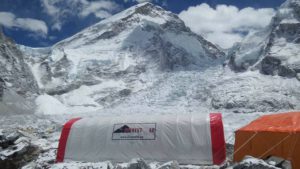
With 600 people and yaks, Zos, and mules wandering around, you never drink water unless it has been boiled and treated.
Another feature of EBC is the location of EverestER. This volunteer team of doctors provides medical services to all foreigners for the bargain price of around $100 each, plus unlimited free services for Sherpas, porters, cooks, and any Nepali. Their service is underwritten thru donations. To get a feel for how the season is going, we can see how many people they treat as a good indicator of EBC health.
Dr. Luanne Freer founded the all-volunteer service in 2003. Today they are part of the Himalayan Rescue Association(HRA), a non-profit organization formed in 1973 to reduce casualties in the Nepal Himalayas. Last spring, EverestER treated 364 patients, including 268 Nepalis.
Lobuche Acclimatization
A program used by many guide companies to reduce the risk of climbing from the south side is to use the 20,000-foot trekking peak, Lobuche East, for acclimatization. This climb will eliminate one rotation thru the Icefall. The altitude is about the same as between Camps 1 and 2 in the Western Cwm. IMG, CTSS, and other teams have used this peak for years.
Yesterday, April 16, one of the IMG teams climbed to the summit and is already back at Lobuche Base Camp. The climb takes a bit over four hours, and we have reports of a “hard but good day.” You get amazingly clear views of Everest, Lhotse, Nuptse, Makalu, and more from the summit.
Adjustments
The story is that everyone is adjusting to their new environment. Some to the new food, others to the thin air, and a few are rethinking their climbing objective.
The trek-in was a time to reflect on why you were there and if you were ready. Almost everyone has a moment of doubt; that is normal. When you begin to feel the thin air at 16,000 feet or stop to take a breather on a small hill, those doubts enter your mind.
But it is OK. The body is adjusting. With the thin air, the body responds by breathing faster. So in a contradictory moment, when you feel like to are not ready, it is just the opposite; your body is busy making the necessary adjustments.
In other words, the business of climbing Everest will be in full motion.
The Puja
Your tent, the one in the middle of a row of seven, seems to catch the first rays of the sun. This is good as it quickly warms your cocoon. Then you remember, “It’s Puja morning.” So you grab your “sharps”, boots – anything that will touch the ground, touch Sagarmatha, touch Chomolungma.
You head to breakfast. It’s quick this morning as the Sherpas have been preparing for hours. The Lama spent most of the night cooking tiny pastries that will adorn the Alter. The Lama hiked in from a village to perform the ceremony. He does this for your team and many others. He gets several thousand rupees for all of these – not a bad gig if you can get it. But cynicism aside, his demeanor, tone, and reverence give you pause halfway through the ceremony.
The Sherpas seem to have a high level of energy this morning. They move at a quickened pace that you rarely witness.
A large stone Stupa has already been erected primarily to hold the flag pole and a picture of the Dali Lama. Blankets are laid out for the climbers to sit on during the long ceremony. The Sherpas are busy stringing the multi-color prayer flags across the camp, and all are centered on the flag pole at the Stupa.

Soon the sounds of the fluttering flags cover the entire camp. Each flag has a different meaning: yellow-earth, green water, red-fire, white-air, blue-space.

More Sherpas are busy starting a small juniper fire. The smoke will cover the entire camp. It is hazy and fragrant. It marks the beginning of something special. This is not the last time you will see this smoke. Every time before leaving Base Camp, each climber and Sherpa will pass by this same spot, letting the smoke from the juniper boughs cover them. More on this later.
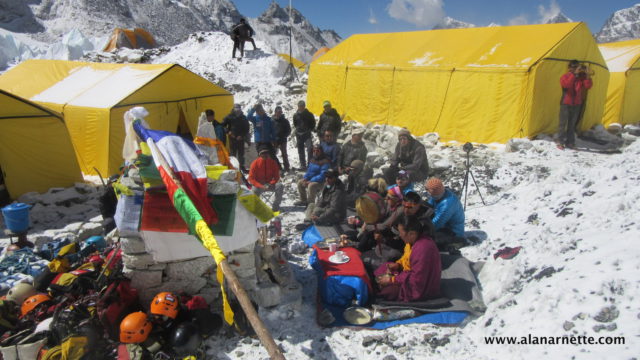
Everyone takes their place on the blankets after resting their climbing tools against the Stupa. Part of the ceremony is to ask forgiveness for hurting Chomolungma with the sharp points of the tools. But the most important part is to ask permission to climb the mountain and for safe passage. “Forgiveness, permission and safety,” you think these are qualities we should express every day.
The Lama begins with a low chant as he reads from the 300-year-old Tibetan prayer book. Everyone soon quiets down as the chanting occupies the entire team of Sherpas. Soon, a Sherpa laughs, others smile, and the environment is respectful but not overly serious.
One Sherpa begins to walk around offering snacks and Chiang to everyone. You shake your head, not wanting to drink any alcohol. It’s OK not to drink the firewater: the Sherpa smiles and moves on. Everyone is now relaxed as the Lama continues his chanting. A small black bird lands on the top of the flag pole, a Himalaya Chuff; it signifies good luck. Everyone smiles.
Without notice, the Lama and Sherpas performing the ceremony stand up. Another low baritone sound emerges. It raises and lowers, rises and lowers then on a mysterious signal, everyone takes their handful of rice and throws it into the air three times, saying another mysterious chant. You have no clue, but it doesn’t matter. Now everyone joins in doing their best imitation of a Tibetan chant. Listening carefully, you think the Tibetan ancestors would be pleased.
Thinking the Puja is over now that rice has been thrown in the air (actually, it was to ward off evil spirits,) the puja moves to the next chapter. The Lama stops his chanting. Everyone stands up and begins to wander. But there is a system to this ceremony you simply don’t understand.
Suddenly, there is a commotion as a Sherpa with a handful of brown powered, barley flour and spreads it all over your face. You really are confused, but it is a good thing as laughter abounds. It symbolizes a white beard and long life. Soon everyone is smearing barley flour on one another.
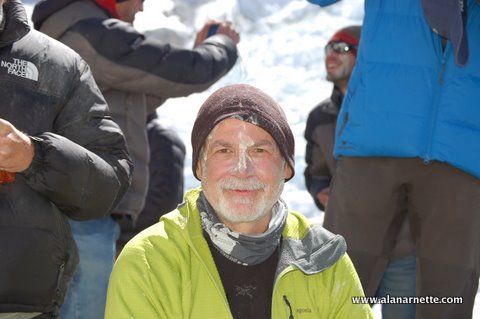
Then something occurs you might never understand. One of the senior Sherpas opens the bottle of Jonnie Walker Whisky (no ‘e’ in this Scotch!). He pours a wee bit of the whisky into the cap and offers it to one of your teammates. He gingerly takes the cap and drinks. The Sherpa repeats this two more times. But as you saw the Sherpas do it, before they drink, they put one finger into the cap, barely dabbing their fingertip and then throwing it over their left shoulder three times. It’s a mystery.
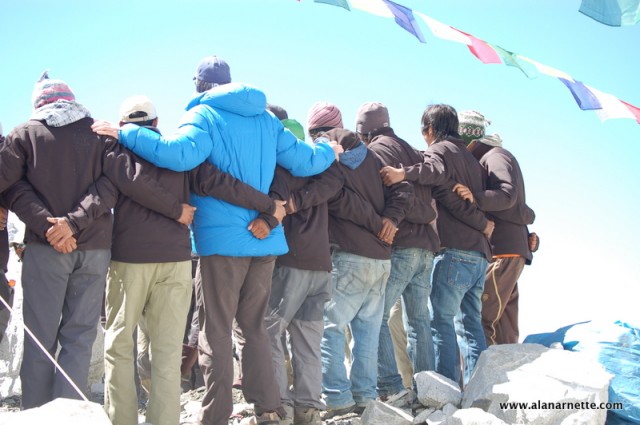
More laughing, and then the dancing starts. The Sherpas, with arms around one another, form a line and begin a dance that would make the Rockets proud. The climbers and trekkers join in. Another Sherpa walks around with the bottle of whisky, carefully pouring a small amount into the bottle cap, most everyone has a taste. More laughs and smiles.
The ceremony ends with a whimper as people drift away, deep in their thoughts about what the ceremony meant to them.
You return to your tent, emotions fully engaged. Clearly, for the Sherpas, it is an homage to Miyolangsangma, the Tibetan Goddess of Mountains, who lives on the summit of Everest. For others, it was a simple ceremony that symbolized the beginning of the climb. And for others, it was entertainment, dismissing the beliefs of others.
You slowly let the ceremony seep in. The sounds, the visions, the seriousness the Sherpas took in placing the prayer flags, building the Alter, placing the tokens, sharps, and pictures. The sound of the Lama reciting the Buddhist prayers and the simple quiet between the moments.
No, you didn’t drink the Johnny Walker. But, yes, you turned your head and nodded when the Sampa was offered as an indication of long life. And yes, you felt the connection between what many consider commercialization and the reason so many people are here to climb Chomolungma.
Perhaps your true reason for your “why” is revealed. And yet, you retreat to the simple answers given before you left home, the reason you told yourself. And the veneer is slowly peeling away.
Climb On!,
Alan
Memories are Everything
Follow Along!
I’m updating my annual team location table and track climber’s blogs (see sidebar). If you have a team not listed, please let me know, and I will add them if I can track them. Likewise, please contact me if you prefer not to be mentioned. Finally, if you would like to see anything special this year, post a comment or drop me an email.
Here’s the video podcast version of this weekend’s update:
The Podcast on alanarnette.com
You can listen to #everest2022 podcasts on Spotify, Apple Podcast, Google Podcasts, Pocket Casts, RadioPublic, Anchor, and more. Just search for “alan arnette” on your favorite podcast platform.
Why this coverage?
I like to use these weekend updates to remind my readers that I’m just one guy who loves climbing. With 35 serious climbing expeditions including four Everest trips under my belt and a summit in 2011, I use my site to share those experiences, demystify Everest each year and bring awareness to Alzheimer’s Disease. My mom, Ida Arnette, died from this disease in 2009 as have four of my aunts. It was a heartbreaking experience that I never want anyone to go through so I ask for donations to non-profits where 100% goes to them and nothing ever to me.![]()

Previous Everest 2022 Season Coverage Posts
- Everest 2022: Welcome to Everest 2022 Coverage
- Everest 2022: Climbers Leave for Nepal
- Everest 2022: Icefall Doctors leave for EBC and Ukraine Guide Bans Russians
- Everest 2022: A look at This Spring’s 8000ers
- Everest 2022: Leaving Nothing Unsaid
- Everest 2022: Weekend Update March 27 – And We’re Off!
- Everest 2022: Climbers to Watch – Updated
- Everest 2022: Weekend Update April 3 – Trekking
- Everest 2022: The Moments I First Considered Climbing Everest, and Your’s?
- Everest 2022: Interview with Garrett Madison from Namche Bazaar
- Everest 2022: Weekend Update April 10 – First 8000er Summits
- Everest 2022: First Death on an 8000er this season – Update
- Everest 2022: Teams Arrive at Everest Base Camp
- Everest 2022: Sherpa Death on Everest

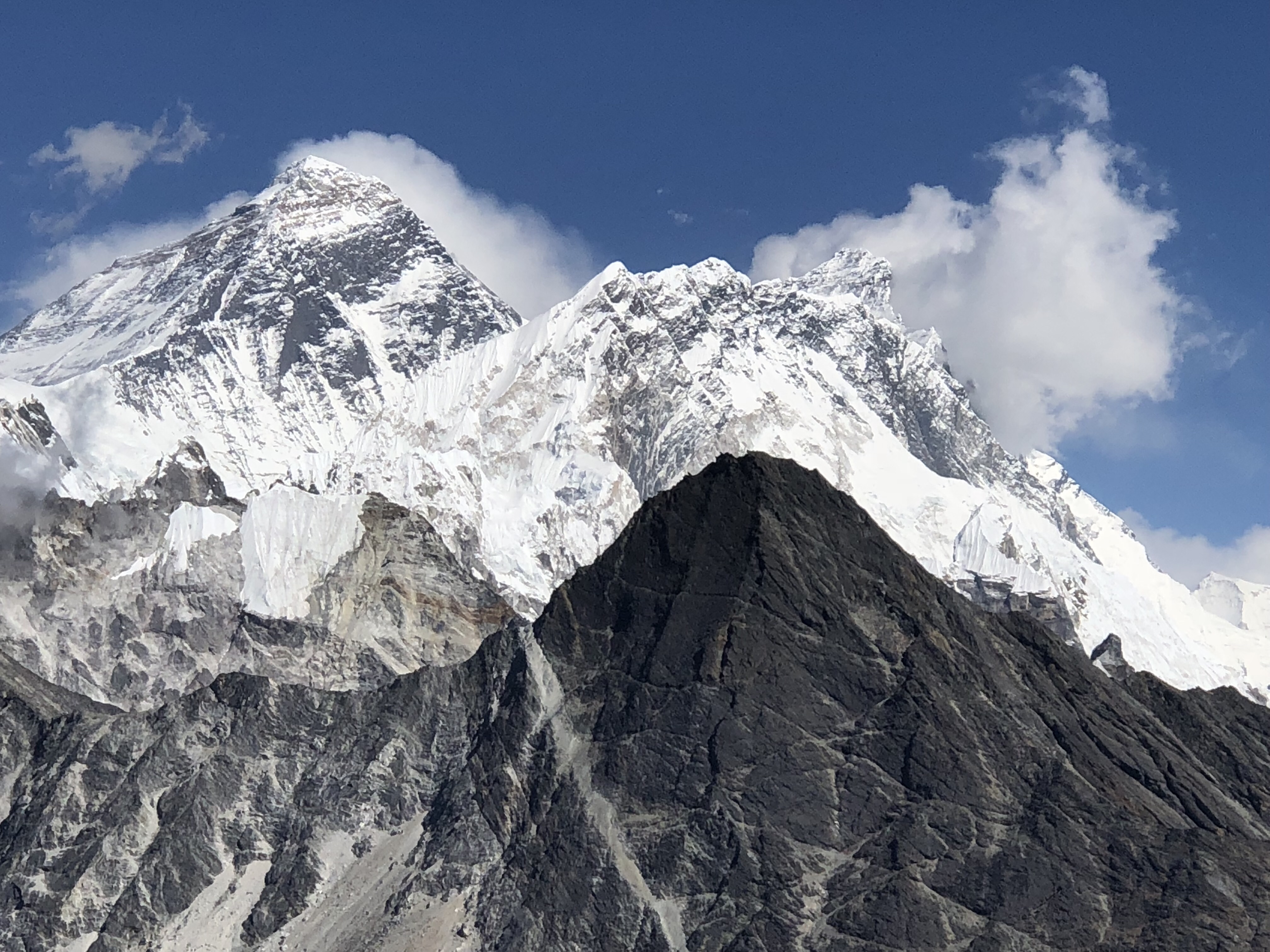
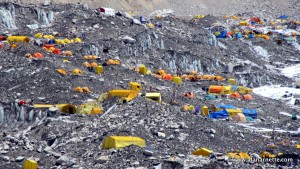
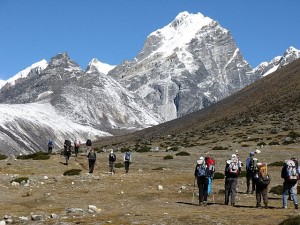
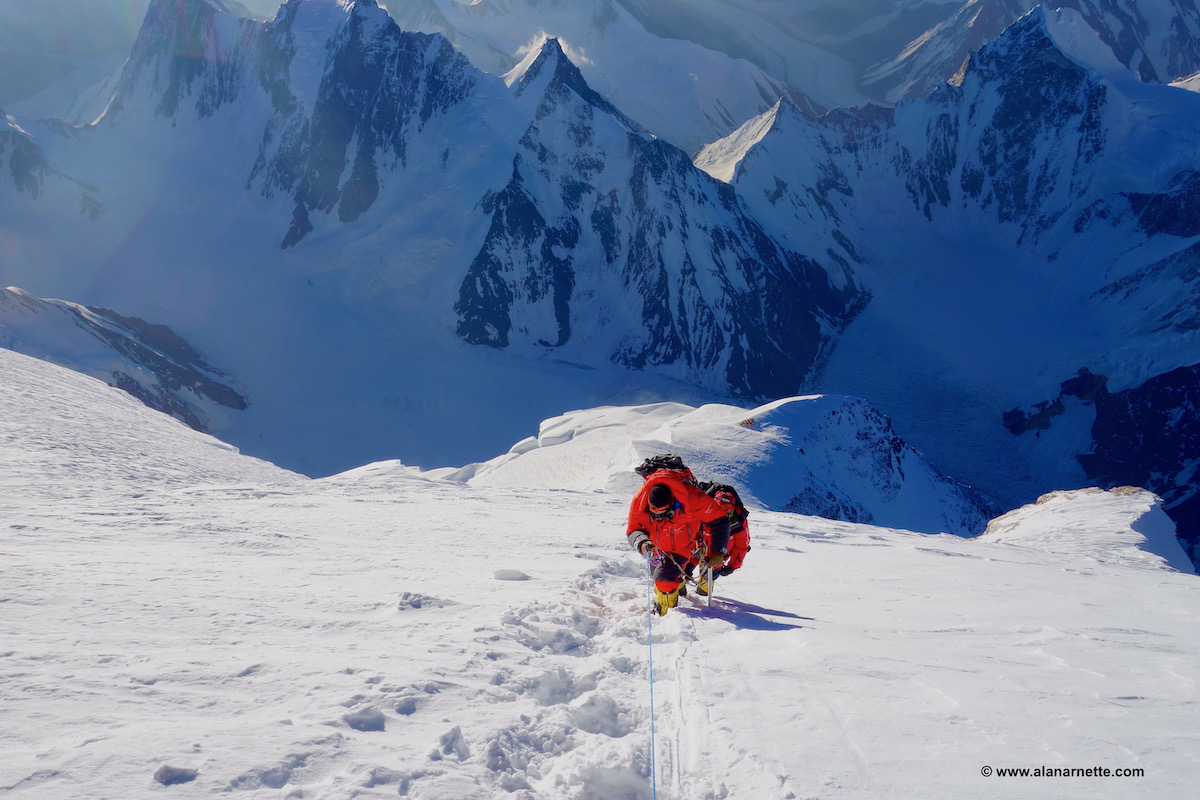

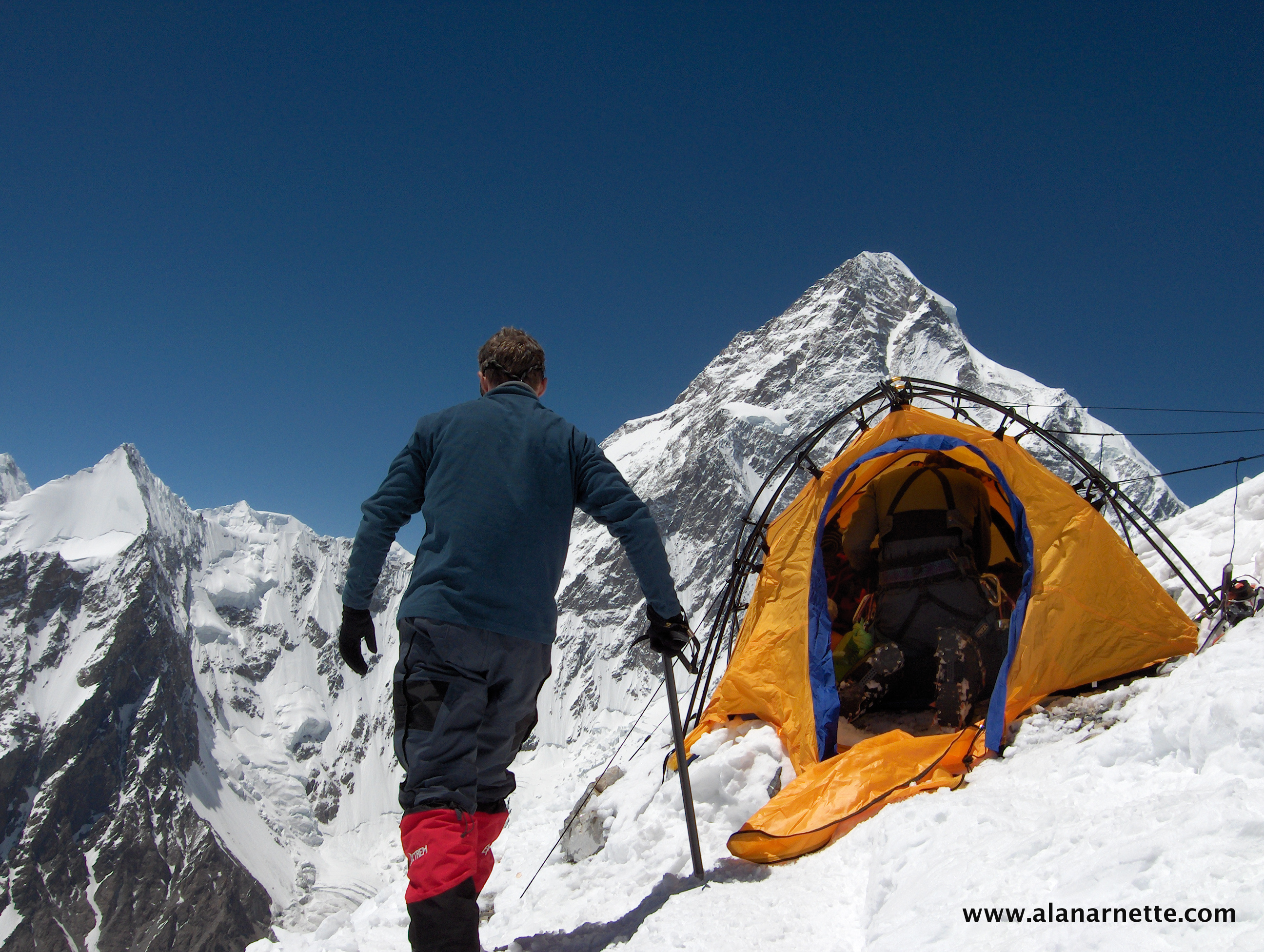
2 thoughts on “Everest 2022: Weekend Update April 17 – First Deaths, Carlos on his Way!”
The WiFi rates don’t seem unreasonable. What’s a couple of hundred dollars when the total for a trip is >$50k?
Yup, That’s they way I’ve always lokked at it.
Comments are closed.